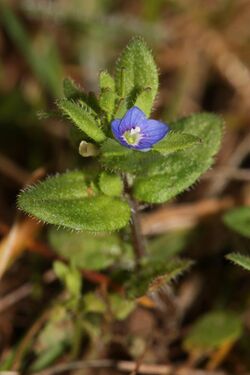Biology:Veronica arvensis
| Veronica arvensis | |
|---|---|

| |
| Scientific classification | |
| Kingdom: | Plantae |
| Clade: | Tracheophytes |
| Clade: | Angiosperms |
| Clade: | Eudicots |
| Clade: | Asterids |
| Order: | Lamiales |
| Family: | Plantaginaceae |
| Genus: | Veronica |
| Species: | V. arvensis
|
| Binomial name | |
| Veronica arvensis | |
Veronica arvensis, common names: wall speedwell,[1]:592 corn speedwell, common speedwell, rock speedwell,[2] field speedwell,[3] is an annual flowering plant in the plantain family Plantaginaceae. The species is native to Europe and a common weed in gardens, pastures, waste places, and cultivated land.[1]
Description
It is a hairy, erect to almost recumbent, annual herb, 9 to 40 centimetres (3.5 to 15.7 in) high from a taproot. The leaves are oppositely arranged in pairs about the stem. The lower leaves have short petioles; the upper are sessile. Each leaf, 1.5 to 2.5 centimetres (0.59 to 0.98 in) in length, is ovate, or triangular with a truncated or slightly cordate base, with coarse teeth. Borne in a raceme, initially compact but elongating with age, the flowers are pale blue to blue-violet, 2 to 3 mm in diameter, four-lobed with a narrow lowest lobe. Flower stalks are 0.5 to 2 millimetres (0.020 to 0.079 in) and shorter than the bracts. The fruit capsules are heart-shaped and shorter than the sepal-teeth. It flowers from April to October.[1]
Distribution
It is native to Africa, Asia and Europe.[4]
Growth
Veronica arvensis plants go through changes in their germination[5] due to temperature and light that control the timing of growth in buried seed reserves. These plants tend to germinate in consistent temperature ranges of 10 degrees Celsius to 15 degrees Celsius.[citation needed] If they do not make the first autumn cycle of growth, they can grow in the following spring.[citation needed]
Uses
It is a medicinal plant.
Uses (Ethnobotany): The herb is alterative, antiscorbutic and diuretic. It has been used used for the treatment of scurvy, impurities of the blood etc. It is also used as a remedy for scrofulous affections, especially of the skin, and is bruised and applied externally for healing burns and ulcers.
References
| Wikimedia Commons has media related to Veronica arvensis. |
- ↑ 1.0 1.1 1.2 Stace, Clive (April 2010). New Flora of the British Isles. ISBN 9780521707725.
- ↑ Veronica arvensis at USDA PLANTS Database
- ↑ Popay I., Champion P. & James T. (2010). An Illustrated Guide to Common Weeds of New Zealand, Third edition. p. 286. New Zealand Plant Protection Society (Inc.), Christchurch, New Zealand. ISBN:978-0-473-16285-6.
- ↑ Veronica arvensis at Germplasm Resources Information Network - (GRIN)
- ↑ Baskin, Jerry; Baskin, Carol (March 1983). "Germination Ecology of Veronica arvensis". Journal of Ecology 71 (1): 57–68. doi:10.2307/2259963.
Wikidata ☰ Q157903 entry
 |

